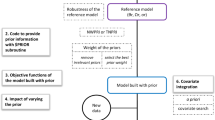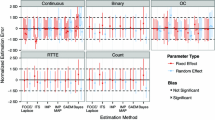Abstract
The aim of this study is to benchmark two Bayesian software tools, namely Stan and GNU MCSim, that use different Markov chain Monte Carlo (MCMC) methods for the estimation of physiologically based pharmacokinetic (PBPK) model parameters. The software tools were applied and compared on the problem of updating the parameters of a Diazepam PBPK model, using time-concentration human data. Both tools produced very good fits at the individual and population levels, despite the fact that GNU MCSim is not able to consider multivariate distributions. Stan outperformed GNU MCSim in sampling efficiency, due to its almost uncorrelated sampling. However, GNU MCSim exhibited much faster convergence and performed better in terms of effective samples produced per unit of time.












Similar content being viewed by others
References
Macheras P, Iliadis A (2016) Modeling in pharmacokinetics and pharmacodynamics: homogeneous and heterogeneous approaches. Springer, New York
Tsamandouras N, Rostami-Hodjegan A, Aarons L (2015) Combining the bottom up and top down approaches in pharmacokinetic modelling: fitting PBPK models to observed clinical data. Br J Clin Pharmacol 79(1):48–55. https://doi.org/10.1111/bcp.12234
Clewell HJ, Clewell RA, Andersen ME (2011) Physiologically-based pharmacokinetic (PBPK) modeling and risk assessment. In: Nriagu J (ed) Encyclopedia of environmental health. Elsevier, New York, pp 536–570. https://doi.org/10.1016/B978-0-444-52272-6.00599-7
Nestorov I (2003) Whole body pharmacokinetic models. Clin Pharmacokinet 42(10):883–908. https://doi.org/10.2165/00003088-200342100-00002
Edginton AN, Theil FP, Schmitt W, Willmann S (2008) Whole body physiologically-based pharmacokinetic models: their use in clinical drug development. Expert Opin Drug Metab Toxicol 4(9):1143–1152. https://doi.org/10.1517/17425255.4.9.1143
Wendling T, Dumitras S, Ogungbenro K, Aarons L (2015) Application of a Bayesian approach to physiological modelling of mavoglurant population pharmacokinetics. J Pharmacokinet Pharmacodyn 42(6):639657. https://doi.org/10.1007/s10928-015-9430-4
Zhuang X, Lu C (2016) PBPK modeling and simulation in drug research and development. Acta Pharmaceutica Sinica B 6(5):430440. https://doi.org/10.1016/j.apsb.2016.04.004
Gelman A, Bois FY, Jiang JM (1996) Physiological pharmacokinetic analysis using population modeling and informative prior distributions. JASA 91(436):1400–12. https://doi.org/10.2307/2291566
Wakefield J (1996) The Bayesian analysis of population pharmacokinetic models. J Am Stat Assoc 91(433):6275. https://doi.org/10.2307/2291383
Bois FY, Jamei M, Clewell HJ (2010) PBPK modelling of inter-individual variability in the pharmacokinetics of environmental chemicals. Toxicology 278(3):256267. https://doi.org/10.1016/j.tox.2010.06.007
Krauss M, Schuppert A (2016) Assessing interindividual variability by Bayesian-PBPK modeling. Drug Dis Today Dis Model 22:15–19. https://doi.org/10.1016/j.ddmod.2017.08.001
Krauss M, Tappe K, Schuppert A, Kuepfer L, Goerlitz L (2015) Bayesian population physiologically-based pharmacokinetic (PBPK) approach for a physiologically realistic characterization of interindividual variability in clinically relevant populations. PLoS ONE 10(10):e0139423. https://doi.org/10.1371/journal.pone.0139423
Mezzetti M, Ibrahim JG, Bois FY, Ryan LM, Ngo L, Smith TJ (2003) A Bayesian compartmental model for the evaluation of 1,3-butadiene metabolism. J R Stat Soc Ser C 52:291–305. https://doi.org/10.1111/1467-9876.00405
Zurlinden TJ, Reisfeld B (2016) Physiologically based modeling of the pharmacokinetics of acetaminophen and its major metabolites in humans using a Bayesian population approach. Eur J Drug Metab Pharmacokinet 41(3):267–80. https://doi.org/10.1007/s13318-015-0253-x
Geyer CJ (2011) Introduction to Markov Chain Monte Carlo. In: Brooks S, Gelman A, Jones GL, Meng XL (eds) Handbook of Markov Chain Monte Carlo, 2nd edn. CRC Press, Boca Raton
Bois FY (2009) GNU MCSim: Bayesian statistical inference for SBML-coded systems biology models. Bioinformatics 25(11):1453–1454. https://doi.org/10.1093/bioinformatics/btp162
Carpenter B, Gelman A, Hoffman MD, Lee D, Goodrich B, Betancourt M, Brubaker M, Guo J, Li P, Riddell A (2017) Stan: a probabilistic programming language. J Stat Softw https://doi.org/10.18637/jss.v076.i01
Hoffman MD, Gelman A (2014) The no-U-turn sampler: adaptively setting path lengths in Hamiltonian Monte Carlo. J Mach Learn Res 15:1593–1623
Weber S, Gelman A, Lee D, Betancourt M, Vehtari A, Racine-Poon A (2018) Bayesian aggregation of average data. Ann Appl Stat https://doi.org/10.1214/17-AOAS1122
Langdon G, Gueorguieva I, Aarons L, Karlsson M (2007) Linking preclinical and clinical whole-body physiologically based pharmacokinetic models with prior distributions in NONMEM. Eur J Clin Pharmacol 63(5):485–498. https://doi.org/10.1007/s00228-007-0264-x
Gueorguieva I, Aarons L, Rowland M (2006) Diazepam pharmacokinetics from preclinical to Phase I using a Bayesian population physiological model with informative prior distributions in WINBUGS. J Pharmacokinet Pharmacodyn 33(5):571594. https://doi.org/10.1007/s10928-006-9023-3
Greenblatt DJ, Allen MD, Harmatz JS, Shader RI (1980) Diazepam disposition determinants. Clin Pharmacol Ther 27(3):301312
Gueorguieva II, Nestorov IA, Rowland M (2004) Fuzzy simulation of pharmacokinetic models: case study of whole body physiologically based model of Diazepam. J Pharmacokinet Pharmacodyn 31(3):185213. https://doi.org/10.1023/B:JOPA.0000039564.35602.78
Leggett RW, Williams LR, Eckerman KF (1995) A blood circulation model for reference man. Health Phys 69(2):187–201
Nestorov IA (2001) Modelling and simulation of variability and uncertainty in toxicokinetics and pharmacokinetics. Toxicol Lett 120(1–3):411–420
Luecke RH, Wosilait WD, Slikker W Jr, Young JF, Pearce BA (2007) Postnatal growth considerations for PBPK modeling. J Toxicol Environ Health A 70(12):1027–1037. https://doi.org/10.1080/15287390601172056
Mould DR, Upton RN (2013) Basic concepts in population modeling, simulation, and model-based drug development-part 2: introduction to pharmacokinetic modeling methods. CPT Pharmacometrics Syst Pharmacol 2(4):e38. https://doi.org/10.1038/psp.2013.14
Stan Development Team (2018) Stan modeling language users guide and reference manual. Version 2(18). http://mc-stan.org
Lewandowski D, Kurowicka D, Joe H (2009) Generating random correlation matrices based on vines and extended onion method. J Multivar Anal 100(9):1989–2001. https://doi.org/10.1016/j.jmva.2009.04.008
Papaspiliopoulos O, Roberts GO, Skld M (2007) A general framework for the parametrization of hierarchical models. Sta Sci 22(1):59–73
Neal RM (2011) MCMC using Hamiltonian dynamics. In: Brooks S, Gelman A, Jones GL, Meng XL (eds) Handbook of Markov Chain Monte Carlo, 2nd edn. CRC Press, Boca Raton, pp 113–162
Monnahan CC, Thorson JT, Branch TA (2018) Faster estimation of Bayesian models in ecology using Hamiltonian Monte Carlo. Methods Ecol Evol 8:339–348. https://doi.org/10.1111/2041-210X.12681
Betancourt M (2017) A conceptual introduction to Hamiltonian Monte Carlo. arXiv:1701.02434v2
Betancourt M (2016) Diagnosing suboptimal cotangent disintegrations in Hamiltonian Monte Carlo. arXiv:1604.00695
Margossian C, Gillespie B (2017) Differential equation based models in Stan. Stan Conference. https://doi.org/10.5281/zenodo.1284264
Bois FY, Maszle DR (1997) MCSim: a simulation program. J Stat Softw https://doi.org/10.1093/bioinformatics/btp162
Hindmarsh AC, Brown PN, Grant KE, Lee SL, Serban R, Shumaker DE, Woodward CS (2005) SUNDIALS: suite of nonlinear and differential/algebraic equation solvers. ACM Trans Math Soft 31(3):363–96
Gelman A, Carlin JB, Stern HS, Dunson DB, Vehtari A, Rubin DB (2001) Bayesian data analysis, 3rd edn. CRC Press, Boca Raton, pp 284–287
Gelman A, Rubin DB (1992) Inference from iterative simulation using multiple sequences. Stat Sci 7(4):457–472
Betancourt MJ, Girolami M (2013) Hamiltonian Monte Carlo for hierarchical models. arXiv:1312.0906
Garcia RI, Ibrahim JG, Wambaugh JF, Kenyon EM, Setzer RW (2015) Identifiability of PBPK models with applications to dimethylarsinic acid exposure. J Pharmacokinet Pharmacodyn 42(6):591–609. https://doi.org/10.1007/s10928-015-9424-2
Yates JWT (2006) Structural identifiability of physiologically based pharmacokinetic models. J Pharmacokinet Pharmacodyn 33(4):421–39. https://doi.org/10.1007/s10928-006-9011-7
Hsieh NH, Reisfeld B, Bois F, Chiu WA (2018) Applying a global sensitivity analysis workflow to improve the computational efficiencies in physiologically-based pharmacokinetic modeling. Front Pharmacol 9:588. https://doi.org/10.3389/fphar.2018.00588
Carpenter B, Hoffman MD, Brubaker M, Lee D, Li P, Betancourt M (2015) AThe Stan Math Library: reverse-mode automatic differentiation in C++. arXiv:1509.07164
Acknowledgements
We would like to thank Gueorgieva I. for granting us access to the Diazepam data. H. Sarimveis and F. Bois acknowledge financial support by OpenRiskNet (Grant Agreement 731075), a project funded by the European Commission under the Horizon 2020 Programme. Periklis Tsiros acknowledges financial support by the NTUA internal reward Programme Numbered 95/0085.
Author information
Authors and Affiliations
Corresponding author
Additional information
Publisher’s Note
Springer Nature remains neutral with regard to jurisdictional claims in published maps and institutional affiliations.
Appendices
Appendix 1: Coefficients of organ weight polynomials for humans
Appendix 2: Posterior estimates
Appendix 3: Impact of LKJ prior on computational efficiency
See Table 8.
Appendix 4: Comparison of the univariate models using noninformative priors
Rights and permissions
About this article
Cite this article
Tsiros, P., Bois, F.Y., Dokoumetzidis, A. et al. Population pharmacokinetic reanalysis of a Diazepam PBPK model: a comparison of Stan and GNU MCSim. J Pharmacokinet Pharmacodyn 46, 173–192 (2019). https://doi.org/10.1007/s10928-019-09630-x
Received:
Accepted:
Published:
Issue Date:
DOI: https://doi.org/10.1007/s10928-019-09630-x






